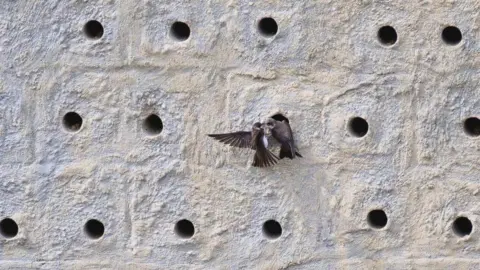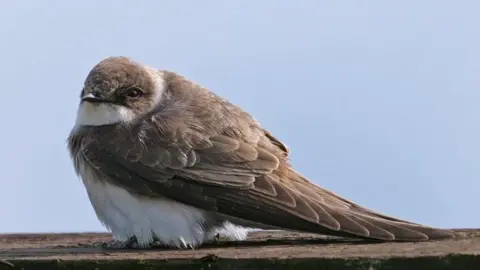Breeding hopes as sand martins return to reserve
 Mark Whitelock
Mark WhitelockThe first sand martins of the season have returned to a nature reserve.
The migratory birds bred at Washington Wetland Centre for the first time in its history last summer after an artificial nesting bank was introduced in October 2023.
The centre said it was difficult to get an accurate number of successfully fledged sand martins due to their agility and speed, but it thought at least 60 to 100 young birds managed to leave the nests.
The team is now hoping for a second successful breeding season.
Sand martins typically lay four to five eggs per clutch and have the potential to raise two broods per season.
The first sand martin chick was spotted on 12 June last year and the final youngster to fledge was noted on 29 August.
 Christopher Bill
Christopher BillSand martins are the smallest of the European hirundine family, which also includes swallows and house martins.
They typically hunt and feed over the reserve's Wader Lake in spring, but their previous attempts to dig natural nesting chambers in the nearby banks of the River Wear had proved unsuccessful.
The artificial nesting structure is made up of cavity blocks and a series of holes which the sand martins can fly into. It also has a tunnel and nest chamber.
Reserve warden Kate Ferguson said: "We weren't sure how the birds would take to the new bank, but our nerves didn't last long, and we were soon excited to see nesting activity around the chambers followed by lots of coming and going before finally being rewarded with the sight of tiny heads of young birds popping out.
"It really was a treat!"
'Penthouse' nests popular
Visitors were asked to help track the movement of the sand martins around the bank, with about 217 citizen science surveys completed between April and August.
Ms Ferguson said: "The top two rows of chambers were most popular, who doesn't love a penthouse, right?
"The reality is possibly more to do with greater protection from ground-dwelling predators, as they are almost 3m above the ground."
She added the sand martins were not afraid to "collectively defend their nests".
The colony was spotted twice mobbing corvid species such as crows and magpies as well as a chasing off various gull species.
